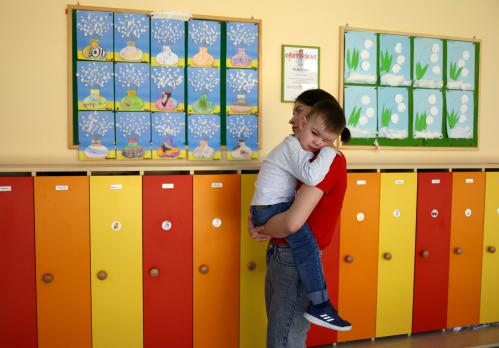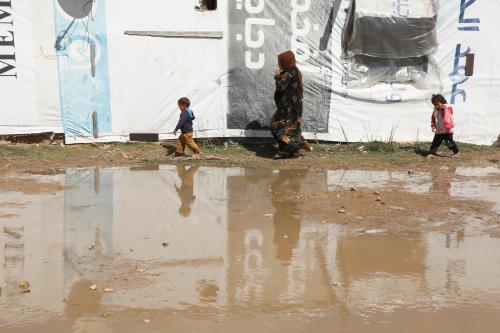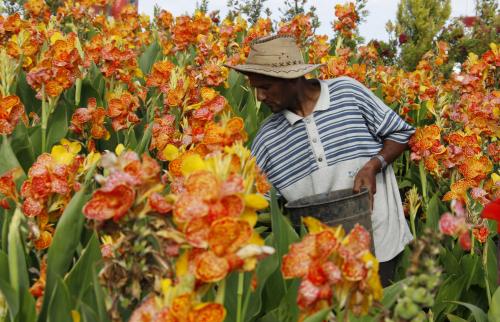In May 2022 as around 15 million Ukrainians fled their homes, the number of people forcefully displaced across the world passed the 100 million mark for the first time. This is equivalent to the world’s 14th largest country, with 53 percent composed of internally displaced peoples (IDPs) and 47 percent of refugees fleeing their countries. Prior to this, there had been 41.1 million refugees in 2010, 71 million in 2018 (led by the 2012-2015 Syrian war upsurge), and 89 million in 2021, with conflicts in Afghanistan, Burkina Faso, the Democratic Republic of Congo, Ethiopia, and elsewhere causing the surge (Table 1).
Table 1. Global-forced displacement by year*
| Year | Forcibly displaced populations |
| June (2022) | 100,000,000 |
| 2021 | 89,000,000 |
| 2020 | 82,400,000 |
| 2019 | 79,500.000 |
| 2018 | 70,800,000 |
| 2017 | 68,500,000 |
| 2016 | 65,500,000 |
| 2015 | 65,100,000 |
| 2014 | 59,200,000 |
| 2013 | 51,200,000 |
| 2012 | 42,700,000 |
| 2011 | 38,500,000 |
| 2010 | 41,100,000 |
Source: UNHCR.
Of the forcibly displaced Ukrainians, some 8 million are IDPs and 7 million are refugees, making it the most rapid and largest single increase in forcibly displaced populations since WWII. There are some 2.2 million returnees, including civilians returning to cities like Kyiv and Kharkiv as men come back to fight, and an end to the violence is unlikely anytime soon.
Poland was the entry point for most Ukrainian refugees (3.7 million), including hundreds of thousands who moved further West, and another 1.5 million who have since returned home. As of June 2022, there were also over a million refugees in Russia, 700,000 in Hungary, 600,000 in Romania (283,000 returnees), and around 500,000 each in Moldova (110,000 returnees) and Slovakia (196,000 returnees). According to the United Nations High Commissioner for Refugees (UNHCR), these neighboring countries aside, the top three Ukrainian refugee hosts are Germany (780,000), the Czech Republic (366,000), and Turkey (145,000).
The welcome and resources made available to the Ukrainian refugees are unprecedented. Under the EU’s Temporary Protection Directive, Ukrainians receive the right to work and access to health, education, housing, and other services for up to three years. Before the war, Ukrainians could enter the EU visa-free for up to three months and a million were working legally and others informally. This diaspora was important in absorbing Ukrainian refugees.
The welcome is in sharp contrast to what asylum seekers from Africa, the Middle East, South Asia, and non-European refugees from Ukraine have faced. Poland continues to prevent non-European migrants from entering the country from Belarus while welcoming Ukrainians. Britain is trying to ship non-European asylum seekers to Rwanda to process applications, and Denmark is likely to follow suit.
This “whole-of-the-EU” approach to the Ukrainian refugee crisis contrasts with the 2015 refugee influx, which prompted many EU members to close their borders to refugees. Yet, the former incorporates useful lessons even though they are unlikely to be extended to non-Europeans anytime soon. While each instance of refugee flows is distinct, some broad lessons emerge. For example, we know that refugees tend to stay displaced for prolonged periods, ranging between 10 and 26 years. European Commission Vice President Margaritis Schinas estimates that up to 3 million Ukrainians will stay in Europe, a boon to a continent facing demographic decline.
But over time, the initial welcome fades. In Turkey the 72 percent support for Syrian refugees in 2016 changed to over 80 percent support for their repatriation—largely due to an economic downturn. Lebanon, already wary of mostly Sunni Syrians in a country with a confessional political balance, soured on refugees after the economy slowed in 2014. Russia’s war on Ukraine has upended life there, but grounds for concern remain in Poland because of pre-war anti-Ukrainian animosity (Poland’s Human Rights Ombudsman recorded 44,000 anti-Ukrainian hate crimes in southern Poland in 2017). While a small minority, extremists can have an oversized role over time. Turkey’s “Victory Party,” which has less than 2 percent of the vote, can still dominate the news cycle with slickly produced videos mimicking the European far-right’s replacement theory espousing that Syrians—roughly 3 percent of the population—are slowly taking over the country. These dynamics are not new; in 1956 when 200,000 Hungarians fled to Austria from invading Soviets, the initial welcome soon frayed and Austria asked others to accept over 90 percent of the refugees.
The Center for Global Development estimates the cost of hosting Ukrainian refugees at $30 billion in the first year. Warsaw’s population has increased by 15 percent, straining services like housing as rent has increased by 40 percent. Other cities have seen sharper population rises, such as Krakow (23 percent) and Gdansk (34 percent). More critically some 600,000 refugees are housed with Polish families, an untenable situation in the long run even with stipends to host families, especially in a country with saturated rental markets. Fault lines may also develop within the refugee community and back home that could exacerbate their situation.
Also, while 72 percent of Syria’s refugees are women and children, that number is 90 percent for Ukrainian refugees. In order to defend the nation, males ages 18-60 are prohibited from leaving Ukraine, thus making women and children refugees, an already at-risk population, even more vulnerable. From trafficking to child care for working women to educational challenges for children, measures need to be deployed and sustained to support women and children. Long-term separation for families portends more challenges.
Gender matters in others way too. In the 2015-16 exodus to Europe of over a million mostly Syrian asylum seekers, 72 percent were males, with 43 percent between the ages of 18 and 34. Without any justification, male refugees were seen as more threatening, prone to crime or radicalization. Many were assumed to be arriving from non-conflict countries like Jordan, Lebanon, and Turkey, and subsequently were portrayed as opportunists unwilling to fight for their countries. All these assumptions feed alarmist nativist narratives.
We also know that it is important that host communities—often more vulnerable in society and lacking appropriate access to good jobs, housing, and other services—are supported. This will diminish potential resentment and also help prevent the false narratives of preferential treatment. Effective policies for integration are needed, from facilitating employment and access to schooling, health, education, housing, and support in learning host languages. The EU is relatively well placed to help here, less so for other refugee host communities.
The longer the conflict lasts, especially as further refugee crises surge, the issue of refugee returns will arise. The World Bank’s Harun Onder notes in a detailed study of Syrian refugees and their return dynamics that better conditions in countries of origin almost always encourage refugee returns as conflicts wane and human and property rights improve. Importantly, adverse conditions in host countries do not automatically lead to increased returns to home countries. However, as the Syrian experience shows, improved conditions in host countries can also lead to more returns as the considerable costs of return become more affordable. The dynamics of Ukrainian refugee returns will be affected by the large number of separated nuclear families and measures facilitating reunification.







Commentary
Forcibly displaced Ukrainians: Lessons from Syria and beyond
June 21, 2022